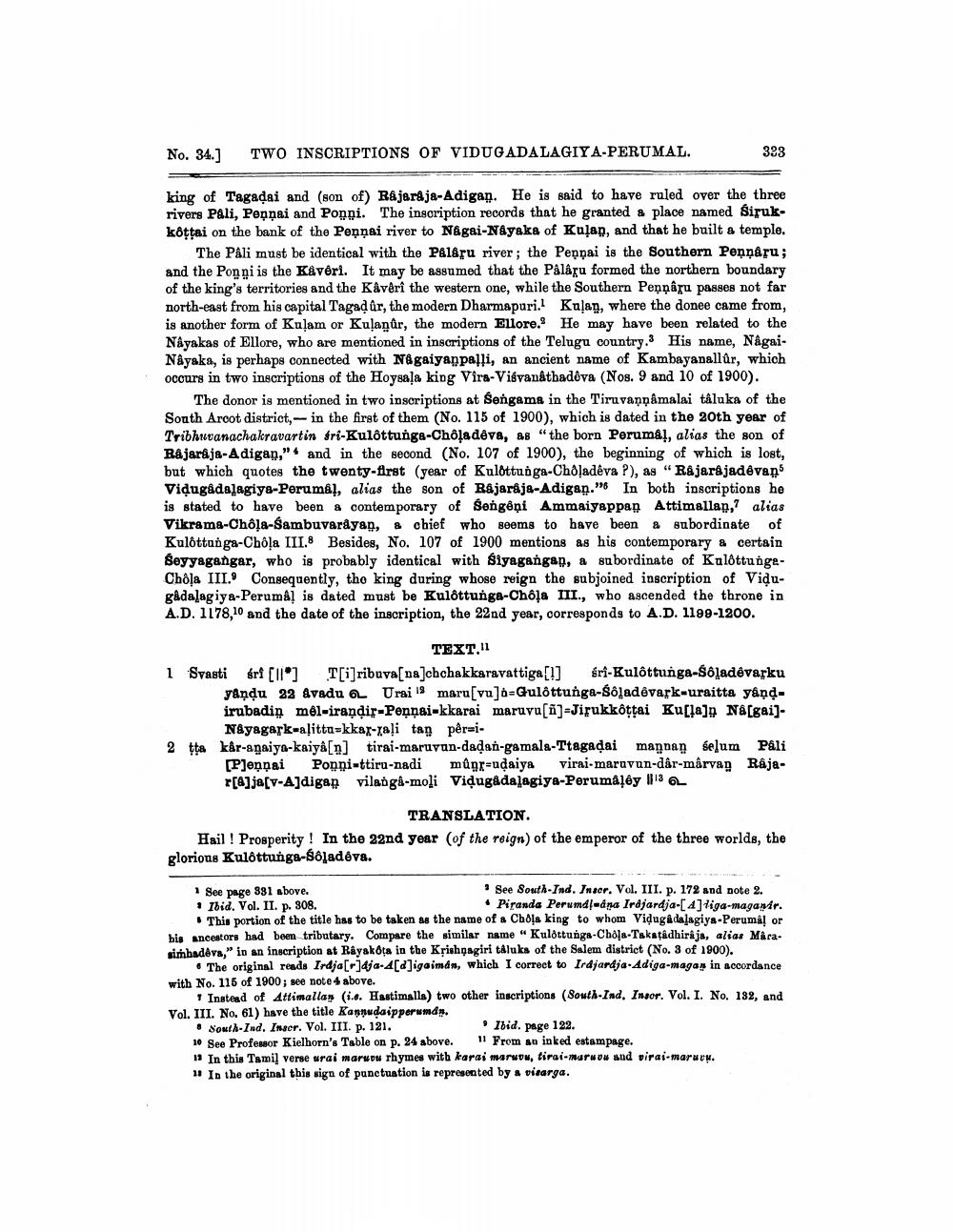________________
No. 34.]
TWO INSCRIPTIONS OF VIDUGADALAGIYA-PERUMAL.
333
king of Tagadai and (son of) Rajaraja-Adigan. He is said to have ruled over the three rivers PAli, Pennai and Poppi. The inscription records that he granted a place named Sirukkottai on the bank of the Peņņai river to Nagai-Nayaka of Kulan, and that he built a temple.
The PAli must be identical with the Palafu river; the Pennai is the Southern Pennáru; and the Ponni is the Kåvēri. It may be assumed that the Paláru formed the northern boundary of the king's territories and the Kávêrî the western one, while the Southern Pennâru passes not far north-east from his capital Tagad úr, the modern Dharmapuri.! Kulan, where the donee came from, is another form of Kuļam or Kulaşûr, the modern Ellore. He may have been related to the Nayakas of Ellore, who are mentioned in inscriptions of the Telugu country. His name, NågaiNayaka, is perhaps connected with Nigaiyappalli, an ancient name of Kambayanallur, which occurs in two inscriptions of the Hoysala king Vira-Vigvan&tbadova (Nos. 9 and 10 of 1900).
The donor is mentioned in two inscriptions at Sengama in the Tiruvannamalai tâluka of the South Arcot district, - in the first of them (No. 115 of 1900), which is dated in the 20th year of Tribhuvanachakravartin sri-Kulôttungs-Chôļadêva, & "the born Perumal, alias the son of Rajaraja-A digan," and in the second (No. 107 of 1900), the beginning of which is lost, but which quotes the twenty-first year of Kulottunga-Choladeva ?), as "Rajarajadêvan Vidugådalagiya-Perumal, alias the son of Rajaraja-Adigan." In both inscriptions he is stated to have been a contemporary of Šengêņi Ammaiyappan Attimallan, alias Vikrama-Chôļa-Sambuvarayan, & chief who seems to have been & subordinate of Kulottunga-Chola III. Besides, No. 107 of 1900 mentions as his contemporary & certain Seyyagangar, who is probably identical with siyagangan, a subordinate of KalôttungeChôļa III. Consequently, the king during whose reign the subjoined inscription of Vidugådalagiya-Perumal is dated must be Kulôttunga-Chola III., who ascended the throne in A.D. 1178,10 and the date of the inscription, the 22nd year, corresponds to A.D. 1199-1200.
TEXT.11 1 Svasti eri [ll] T[i]ribuva[na]chchakkaravattiga[!] Sri-Kulôttunga-sbladevasku
yandu 22 &vedu 6 Urais maru[vu]Gulottunga-soladêvark-uraitta yaņd. irubadiņ mêl-irandir-Pennsi-kkarai maruvu[n]=Jifukkottai Ku[la] N&[gai)
N&yagark-asitta=kkar-zali tag pèr=i2 ta kår-aņaiya-kaiya[n] tirai-maruvan-dadan-gamala-Ttagadai mannan Selum Påli
[P]eņņai Poppi-ttiru-nadi mûgr=udaiya virai-maravun-dâr-mârvan Rajar[@]ja[v-Ajdigan vilaðgå-moli Vidugådalagiya-Perumaey 16
TRANSLATION Hail ! Prosperity! In the 22nd year (of the reign) of the emperor of the three worlds, the glorions Kulottunga-6ôladéve.
See page 891 above.
* See South-Ind. Inser. Vol. III. p. 172 and note 2. 1 Ibid. Vol. II. p. 308.
• Piranda Perumdana Irdjardja-[4] iga-maganir. This portion of the title has to be taken as the name of a Cha king to whom Vidugadalagiya-Perumal or bis ancestors had been tributary. Compare the similar name "Kulottunga-Cola-Tskatadhiraja, alias Maradirbadáva," in an inscription at Rayskota in the Krishgagiri taluks of the Salem district (No. 3 of 1900).
The original reads Irdja[r]dja-4[d]igaiman, which I correct to Irdjardja.Adiga-maga in accordance with No. 116 of 1900; see note 4 above.
Inotend of Attimalla, (i... Hastimalla) two other inscriptions (South-Ind. Insor. Vol. I. No. 192, and Vol. III. No. 61) have the title Kannudaipperwmdn. • South-Ind. Inser. Vol. III. p. 121.
Ibid. Page 122. 10 Seo Professor Kielhorn's Table on p. 24 above. From an inked estampage. 13 In this Tami) verse wrai maruum rhymes with karai marwow, tirai-murwow and virai-marwuu. 11 In the original this sign of punctuation is represented by a visarga.




